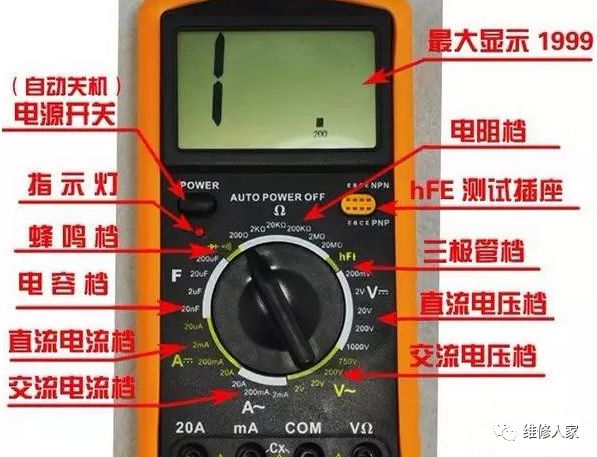
Click “Read the Original Text” or scan the QR code to grab the order

Correctly using a multimeter can not only quickly and accurately identify the fault location but also prevent damage to electrical equipment and the multimeter itself.

1. Before measuring, check the range; don’t measure without checking.
Every time you pick up the probes to prepare for measurement, be sure to double-check whether the measurement category and range selection switch are set correctly. For safety, this habit must be developed.
2. Do not change the range during measurement; return to the null range after measuring.
Do not arbitrarily change the selection knob during measurement, especially when measuring high voltage (like 220V) or large current (like 0.5A), to avoid arcing and damaging the contacts of the switch. After measurement, reset the range selection switch to the “•” position.
3. The dial should be level; the reading must be aligned.
When using a multimeter, it should be rotated level, and the line of sight should be directly aligned with the needle when reading.
4. The range must be appropriate; the needle should deflect more than half.
When selecting the range, if it is not possible to estimate the size of the measured quantity beforehand, try to select a larger range first, then gradually switch to a smaller range based on the angle of deflection until the needle deflects about 2/3 of the full scale.

5. Measure resistance without power; discharge capacitors before measuring capacitance.
It is strictly forbidden to measure resistance in a powered circuit. When checking large capacitors on electrical equipment, discharge the capacitor before measuring.
6. Zero the meter before measuring resistance; adjust to zero when changing ranges.
When measuring resistance, first turn the switch to the resistance setting, short the two probes, and adjust the “Ω” zero potentiometer to make the needle point to zero ohms before measuring. Each time you change the resistance range, you should readjust the ohm zero point.
7. Remember that black is negative; the black lead connects to the “+” inside the meter.
The red probe is the positive lead, and the black probe is the negative lead, but in the resistance setting, the black probe connects to the positive terminal of the internal battery.
8. Measure current in series; measure voltage in parallel.
When measuring current, the multimeter should be connected in series with the circuit being measured; when measuring voltage, the multimeter should be connected in parallel across the two ends of the circuit being measured.
9. Do not reverse polarity; develop a one-hand habit.
When measuring current and voltage, special attention must be paid to ensure that the red and black probes are not reversed, and it is essential to develop the habit of operating with one hand to ensure safety.


Exciting Recommendations
3·15 Consumer Inspection Service Personnel Hold Credentials on Site
The 315 Consumer Rights Protection Innovation Conference for the Home Appliance Service Industry was held in Beijing
Welcome to Submit Articles Let’s Discuss the Development of the Home Appliance Service Industry!
Likes are a form of encouragement; share to spread friendship
